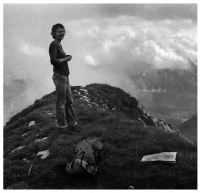CAZypedia celebrates the life of Senior Curator Emeritus Harry Gilbert, a true giant in the field, who passed away in September 2025.
CAZypedia needs your help!
We have many unassigned pages in need of Authors and Responsible Curators. See a page that's out-of-date and just needs a touch-up? - You are also welcome to become a CAZypedian. Here's how.
Scientists at all career stages, including students, are welcome to contribute.
Learn more about CAZypedia's misson here and in this article. Totally new to the CAZy classification? Read this first.
Difference between revisions of "Template:UserPage"
Harry Brumer (talk | contribs) (Created page with "<noinclude> <blockquote class="toccolours" style="float:none; padding: 10px 15px 10px 15px; display:table;"> '''The text below is a template to help CAZypedians create a consi...") |
Harry Brumer (talk | contribs) |
||
| Line 24: | Line 24: | ||
<biblio> | <biblio> | ||
| − | |||
#Sulzenbacher1996 pmid=8952478 | #Sulzenbacher1996 pmid=8952478 | ||
#Sulzenbacher1997a pmid=9153432 | #Sulzenbacher1997a pmid=9153432 | ||
Revision as of 09:22, 1 August 2013
The text below is a template to help CAZypedians create a consistent layout for User Pages. It can be transcluded into new pages via a drop-down menu provided by the MultiBoilerplate extension installed on CAZypedia.
This is an example of a biographical CAZypedia user page. It highlights a number of common formatting features, including internal links to other CAZypedia pages, external links, and the use of automatic reference formatting. Use it as a template by changing, adding, and deleting items to make your own personal page.
Gerlind Sulzenbacher obtained her B.Sc. in Pharmacy from the University of Bologna and completed her PhD under the supervision of Keith Wilson at the University of York, where she worked with ^^^Gideon Davies^^^, and at the EMBL Hamburg Outstation. The work focused on structural studies of glycoside hydrolases from families GH7, GH11 and GH12. In 1999 she obtained a personal EMBO fellowship to join the group of ^^^Bernard Henrissat^^^ at the CNRS laboratory Architecture et Fonction des Macromolecules Biologiques. She is currently permanent research engineer in the group of Yves Bourne at the AFMB laboratory. She has determined the crystal structures of
- GH7 Fusarium oxysporum endoglucanase [1, 2]
- GH11 Bacillus pumilus xylanase
- GH12 Streptomyces lividans endoglucanase [3, 4]
- GH29 Thermotoga maritima α-fucosidase [5]
- GH109 Elizabethkingia meningosepticum α-N-acetylgalactosaminidase [6]
- Sulzenbacher G, Driguez H, Henrissat B, Schülein M, and Davies GJ. (1996). Structure of the Fusarium oxysporum endoglucanase I with a nonhydrolyzable substrate analogue: substrate distortion gives rise to the preferred axial orientation for the leaving group. Biochemistry. 1996;35(48):15280-7. DOI:10.1021/bi961946h |
- Sulzenbacher G, Schülein M, and Davies GJ. (1997). Structure of the endoglucanase I from Fusarium oxysporum: native, cellobiose, and 3,4-epoxybutyl beta-D-cellobioside-inhibited forms, at 2.3 A resolution. Biochemistry. 1997;36(19):5902-11. DOI:10.1021/bi962963+ |
- Sulzenbacher G, Shareck F, Morosoli R, Dupont C, and Davies GJ. (1997). The Streptomyces lividans family 12 endoglucanase: construction of the catalytic cre, expression, and X-ray structure at 1.75 A resolution. Biochemistry. 1997;36(51):16032-9. DOI:10.1021/bi972407v |
- Sulzenbacher G, Mackenzie LF, Wilson KS, Withers SG, Dupont C, and Davies GJ. (1999). The crystal structure of a 2-fluorocellotriosyl complex of the Streptomyces lividans endoglucanase CelB2 at 1.2 A resolution. Biochemistry. 1999;38(15):4826-33. DOI:10.1021/bi982648i |
- Sulzenbacher G, Bignon C, Nishimura T, Tarling CA, Withers SG, Henrissat B, and Bourne Y. (2004). Crystal structure of Thermotoga maritima alpha-L-fucosidase. Insights into the catalytic mechanism and the molecular basis for fucosidosis. J Biol Chem. 2004;279(13):13119-28. DOI:10.1074/jbc.M313783200 |
- Liu QP, Sulzenbacher G, Yuan H, Bennett EP, Pietz G, Saunders K, Spence J, Nudelman E, Levery SB, White T, Neveu JM, Lane WS, Bourne Y, Olsson ML, Henrissat B, and Clausen H. (2007). Bacterial glycosidases for the production of universal red blood cells. Nat Biotechnol. 2007;25(4):454-64. DOI:10.1038/nbt1298 |
